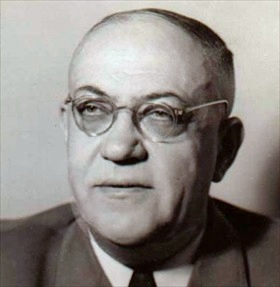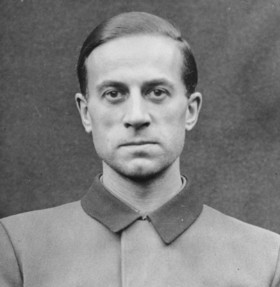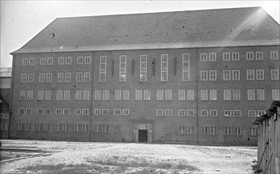AILING HITLER SACKS PERSONAL PHYSICIAN
Wolf’s Lair, Fuehrer HQ, East Prussia · October 10, 1944
Shortly after the July 1944 attempt on Adolf Hitler’s life, an adjutant of the Chief of the General Staff of the Army remarked that the 55-year-old Hitler had the “posture of an old man.” On September 24, 1944, Dr. Theodor Morell, the Fuehrer’s loyal, long-serving physician, noted in his daily calendar that “Patient A” was suffering from heart trouble, stomach aches, and a sore throat. Morell had first met “Patient A” during a party at Hitler’s Alpine retreat, the Berghof, and told the German leader that he could cure him within a year of some of the maladies that plagued him. Morell prescribed various commercial preparations, including a combination of vitamins and E. coli bacteria. Hitler seemed to recover and Morell eventually became a member of Hitler’s de facto family circle as well as a member on his team of personal physicians. On this date in 1944 Hitler sacked Morell’s rival, Dr. Karl Brandt, Reich Commissar for Health and Sanitation and for a time the leading medical authority in the Nazi regime. Brandt had become convinced that the pills Morell prescribed for the Fuehrer were actually poisoning him. Others in Hitler’s inner circle also viewed the good doctor with suspicion, and Morell became the butt of numerous jokes outside of Hitler’s earshot. Luftwaffe chief and Reich Marshall Hermann Goering called Morell “Mr. Reich Injection Master,” “Herr Reichspritzenmeister.” Armaments Minister Albert Speer, one of Hitler’s closest associates, called Morell “a bit of a screwball.” Hitler, however, chose to view negative comments about Morell as a conspiracy. Between 1941 and 1945, Hitler consumed up to 88 different substances, among them opiates, cocaine, barbiturates, methamphetamines, laxatives, tonics, glucose, and useless hormones. By the time of the Normandy invasion (Operation Overlord) in June 1944, Hitler’s sleep disorder and daytime somnolence—common in people with Parkinson’s disease—had noticeably affected his decision-making faculties and allegedly contributed to the slow response of Axis forces in counterattacking Allied beachhead landings. In the month Hitler died, April 1945, Morell was treating Hitler with two belladonna-based drugs, the treatment of choice at that time for tremors. Interned by the Allies after the war, Morell, unlike Brandt, was never charged with any war crimes.
[amazon_carousel widget_type=”ASINList” width=”600″ height=”200″ title=”Recommended Reading” market_place=”US” shuffle_products=”False” show_border=”False” asin=”0465049052,0807846759,1847252060,0195101065,0674745787,0745652220,0521416132,1591810329,0870818090,0801848245″ /]
Hitler’s Personal Physicians: Theodor Morell and Karl Brandt, Chief of the Nazi Euthanasia Program (T-4)
 |  |
Left: A Nazi Party member since 1933, Dr. Theodor Morell (1886–1948) was Hitler’s personal physician. Morell was well known in Germany for his unconventional treatments. A licensed general practitioner, most people in Hitler’s inner circle regarded him as a quack. Hitler’s health deteriorated under the impact of the myriad drugs Morell prescribed. Hitler’s physical decline coincided with his increasingly rare public appearances and his self-imposed isolation in the “Wolfs Lair,” his military headquarters buried deep in the East Prussian forests.
![]()
Right: A member of the paramilitary SS (Schutzstaffel) since July 1934, Dr. Karl Brandt (1904–1948) was selected as Hitler’s “escort physician” the next month. From 1939 onwards he headed the Nazi euthanasia program (Action T‑4), in which thousands of people who were medically diagnosed as “incurably sick” (e.g., handicapped, physically disabled, or mentally ill) were granted a mercy death (Gnadentod). Appointed Reich Commissioner for Health and Sanitation in 1942, he became involved in grotesque medical experiments on concentration camp prisoners on a previously unimaginable scale. Brandt was prosecuted in the first round of the Nuremberg Trials. Convicted of war crimes and crimes against humanity, he was hanged on June 2, 1948.
 |  |
Left: A former jail, the Brandenburg Euthanasia Center, officially known as the Brandenburg Welfare Institute, was established in 1939 and acted as a killing center as part of the Nazi euthanasia program. At first patients were killed by lethal injection, but the doses of increasingly scarce and expensive drugs was soon apparent. Hitler himself recommended to Brandt that carbon monoxide gas be used. At his trial Brandt described this as a “major advance in medical history.” The first gassings took place at Brandenburg in January 1940 and by the end of the year 9,772 people had been asphyxiated.
![]()
Right: Hadamar in the German state of Hessen housed a psychiatric clinic where 10,072 men, women, and children were asphyxiated with carbon monoxide in a gas chamber designed to look like a shower in the first phase of the T‑4 killing operations there (January to August 1941). Another 4,000 died through starvation and by lethal injection until March 1945. Hadamar’s citizens were aware of what was taking place at the clinic, especially since the cremation process was faulty. This often resulted in a cloud of stinking smoke hanging over the town. Local students would often taunt each other by saying, “You’ll end up in the Hadamar ovens!”
Dr. Theodor Morell: “Patient A” and His Secret Illness
![]()

 History buffs, there is good news! The Daily Chronicles of World War II is now available as an ebook for $4.99 on Amazon.com. Containing a year’s worth of dated entries from this website, the ebook brings the story of this tumultuous era to life in a compelling, authoritative, and succinct manner. Featuring inventive navigation aids, the ebook enables readers to instantly move forward or backward by month and date to different dated entries. Simple and elegant! Click
History buffs, there is good news! The Daily Chronicles of World War II is now available as an ebook for $4.99 on Amazon.com. Containing a year’s worth of dated entries from this website, the ebook brings the story of this tumultuous era to life in a compelling, authoritative, and succinct manner. Featuring inventive navigation aids, the ebook enables readers to instantly move forward or backward by month and date to different dated entries. Simple and elegant! Click 











